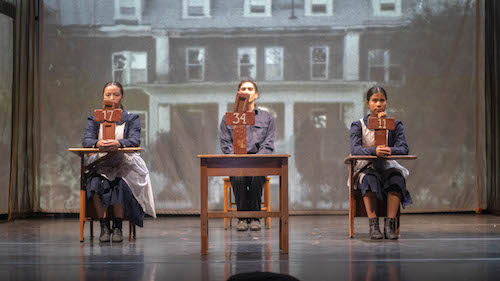 Life in the Residential School system is told through dance at the Young People’s Theatre
Life in the Residential School system is told through dance at the Young People’s Theatre
The cultural – and literal – genocide perpetrated against Indigenous communities via the Residential School system is one of our country’s most shameful actions in a history with no shortage of shame. Taken from their parents, Indigenous children from toddler through teenagehood experienced conditions similar to those at a prison labour camp allowed to operate without any concern for human rights. Beaten and starved, sexually abused and isolated, they were there to have their culture forcibly removed and replaced with degradation and servitude.
Young People’s Theatre’s 2019-2020 season, based around the Seven Ancestral Teachings of the Anishinaabe, opened with The Mush Hole, a dance-theatre piece by Kaha:wi Dance Theatre which is attached to the teaching of Truth. Truth (Debwewin), separate from Honesty, is symbolic of principle and the basic law of nature; it represents a commitment to speaking about one’s experience, and exhibiting resilience, evolving without being fundamentally changed.
This commitment is on full display in Kaha:wi’s wrenching examination of the damaging history of the Mohawk Institute Residential School, Canada’s oldest Residential School, which operated from 1828 to 1970. The company has taken interviews with survivors and turned them into a piece full of multimedia and movement, kinetically and sonically overwhelming at times, that rarely lets up in its blunt depiction of the horrors.
The Mush Hole was the Mohawk Institute’s nickname, representing the watery gruel served to students. Projections of the maggot-filled bowls are shown on screens that form the institute on stage, attached to a large wire frame of its outline. When the bowls disappear to show indoor and outdoor scenes, the beauty of the outdoor escape contrasts with grimy boiler rooms and brick walls where inmates carved messages and names. Names are a big part of the erasure, as each student is primarily identified by number. Physical bricks on stage, initially forming crosses, bear these numbers. The students knock down the bricks and attempt to rebuild, with little success.
A truly haunting touch comes from the shadowy figures that appear in many of the projections, seeming to fade in and out of reality. These are the oppressors; by only showing them in this manner, the company manages to convey the eerie impression of constant surveillance, while leaving the focus solely on the oppressed. When a character is beaten or disciplined, which happens often, the blows come from an unseen force.
The dance pieces don’t tell a clearly linear story, but instead give us moments of pain, many of which are memorable and heartbreaking. A scene set to Hank Williams’ “I’m So Lonesome I Could Cry” has a stark narrative: two parents (company artistic director Santee Smith and Jonathan Fisher) symbolically fight around a kitchen table over the placement of chairs where their children used to sit before being forcibly removed from their home. They steadily drink and grow more and more despondent, turning on each other while grieving.
Another scene, where the children sing a Christian song while others become increasingly disillusioned with religion, is notable for the agony on Smith’s (#29/Mabel) face, stretched in a silent scream. And when Fisher (#48/Ernest) tries to remember one of his family’s songs, only to be drowned out by similar Christian music, you see his intense frustration in his sharp movements.
The three younger actors’ characters feel a little less distinct, partially because they are being taught to behave in a regimented way, but their fear is evident, notably in Montana Summers’ athletic display as #34/Walter is faced with humiliation in an industrial basement. Sometimes the movements got a bit repetitive, which lessened their impact over time as I got used to them – but this itself was a sobering lesson on how easy it is to become numb to horror.
I did find myself wanting to know more about the stories of each of the children – there was only so much that could be conveyed with the movements, particularly in the story of “the one who got away” (#11, played with intensity by Julianne Blackbird). Getting to know each of them in a more specific and less symbolic fashion could have made the very powerful message even more powerful.
The show had a sobering effect on its full audience of students, who commented on its darkness during the talk back. One student asked the cast how they were able to perform the piece without being scared. The actor’s response was at the heart of the show: by telling the story, they are able to show resilience, survival, and hope, even in the face of all this darkness.
Performed in the midst of a federal election that highlighted just how far we still have to go to redress these wrongs, The Mush Hole is a vital teaching tool as we try to move forward with reconciliation.
Details:
- The Mush Hole plays until October 25, 2019 at Young People’s Theatre (165 Front St. E)
- Shows run Wednesday-Thursday at 10:15 am and 1:00 pm, and Friday at 10:15 am.
- Tickets are $10-39 and can be purchased online or by calling 416-862-2222 x2
- Run Time: The show runs 65 minutes.
- Audience Advisory: Recommended for children ages 11 and up. Herbal cigarettes are smoked on stage.
Photo of Semiah Smith, Montana Summers, and Julianne Blackbird by Ian R. Maracle
